Tools - Northern Europe - Recent acquisitions - Sold antiquities
Archive of sold antiquities
All artefacts sold in our gallery are fully documented in our online archive and database. Being a specialist ancient art dealer, preserving also the more recent history of each and every piece sold in our shop is at our heart. That is particularly useful for artefacts that changed owners in the meantime. Information that may have been lost in the process can be easily restored from our archives. Please do not hesitate to contact us if you need further information about ancient items that have been sold in our gallery. We can help you with reconstructing the history of ownership for those items. All information about our customers will be kept confidential, of course.-
 Two Roman lock bolts from Novaesium
Two Roman lock bolts from NovaesiumEach was part of a key lock, e.g. for a door or chest. Finds from the Roman city of Novaesium, today's Neuss in Germany.
Price: on request Roman lead weight from Novaesium
Roman lead weight from NovaesiumTrapezoidal weight from the Roman city of Novaesium, today's Neuss in Germany.
Price: on request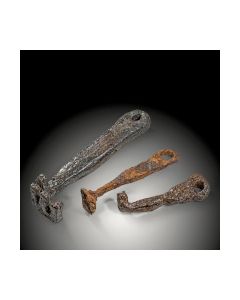 Three Roman iron keys from Novaesium
Three Roman iron keys from NovaesiumIron keys of typical shape. Finds from the Roman city of Novaesium, today's Neuss in Germany.
Price: on request Roman key ring
Roman key ringFinger ring made of bronze with a key. From the Roman Imperial period, around the 2nd century. A find from the Roman city of Novaesium, today's Neuss in Germany.
Price: on request Six neolithic stone tools
Six neolithic stone toolsNice group of artefacts from the Northern European Neolithic. One blade, two dagger fragments and three axe head fragments. All found in Northern Germany.
Price: on request Roman clay ball
Roman clay ballMassive clay sphere, ammunition or a pistill. A find from the Roman city of Novaesium, today's Neuss in Germany.
Price: on request Six Roman iron nails
Six Roman iron nailsDifferent shapes of nails. Finds from the Roman city of Novaesium, today's Neuss in Germany.
Price: on request Neolithischer Axtkopf mit Museumsschäftung
Neolithischer Axtkopf mit MuseumsschäftungDas Steinwerkzeug stammt aus der Jungsteinzeit Nord- oder Mitteleuropas. Besonders hervorzuheben ist die moderne Schäftung in Museumsqualität, die einen großartigen Eindruck von der einstigen Verwendung des Werkzeuges gibt.
Price: on request Roman glass fragments from the Rhineland
Roman glass fragments from the RhinelandFragments of glass vessels and rods, as well as two faience beads. Finds from the Roman city of Novaesium, today's Neuss in Germany.
Price: on request Eight Roman bronze artifacts
Eight Roman bronze artifactsVarious artifacts in different states of preservation. Finds from the Roman city of Novaesium, today's Neuss in Germany.
Price: on request Four Roman iron artefacts
Four Roman iron artefactsArrow heads, chisel and blade made of Iron. Finds from the Roman city of Novaesium, today's Neuss in Germany.
Price: on request Eight Roman bronze artefacts
Eight Roman bronze artefactsVarious artefacts in different states of preservation. Finds from the Roman city of Novaesium, today's Neuss in Germany.
Price: on request Flint knife from Northern Germany
Flint knife from Northern GermanyFlat two-edged stone blade from the Dagger Period of Northern Europe.
Price: on request Stone Age chisel from Northern Germany
Stone Age chisel from Northern GermanyAsymmetrically shaped chisel with two polished sides. Made of light flint. Approx. 3400 to 2400 BC.
Price: on request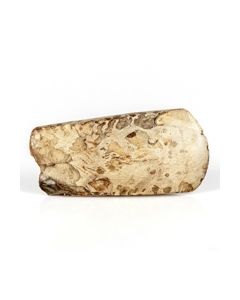 Neolithic thin butted axe head
Neolithic thin butted axe headAxe from the Early Neolithic is made of beautiful reddish brown flint with inclusions. Found in Northern Germany.
Price: on request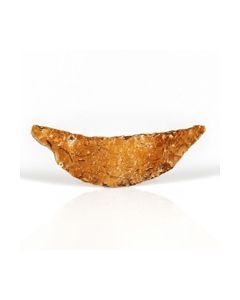 Small Neolithic sickle from Northern Germany
Small Neolithic sickle from Northern GermanyThe crescent-shaped blade is made of reddish brown flint. This tool represents an intermediate state within the radical transition from Neolithic to Bronze Age.
Price: on request Small axe head from the New Stone Age
Small axe head from the New Stone AgeCompact stone axe from the 3rd Millenium BC. Found on the Danish island of Moen.
Price: on request Hammer axe of the Single Grave culture
Hammer axe of the Single Grave cultureGorgeous axe head made of polished dark rock. Made by the Single Grave culture and found in northern Germany.
Price: on request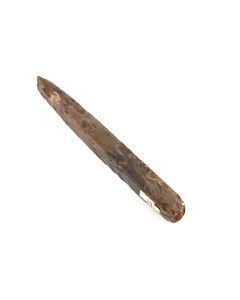 Neolithic chisel from Northern Germany
Neolithic chisel from Northern GermanyElegantly shaped chisel with two polished sides. Made of dark flint. Approx. 3400 to 2400 BC.
Price: on request Neolithic axe head from Luetzow in Northern Germany
Neolithic axe head from Luetzow in Northern GermanyPolished axe made of beautiful brown flint. It was found more than 100 years ago near the town of Luetzow.
Price: on request Dagger blade made of beautiful flint
Dagger blade made of beautiful flintThe finely worked long blade was found in Luetzow in Northern Germany. The artefact was made towards the end of the Neolithic.
Price: on request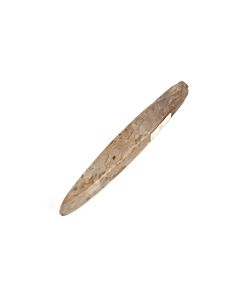 Neolithic chisel from Northern Germany
Neolithic chisel from Northern GermanyElegantly shaped chisel with two polished sides. Made of grey flint. Approx. 3400 to 2400 BC.
Price: on request Neolithic sickle from Northern Germany
Neolithic sickle from Northern GermanyCrescent-shaped blade made of beautiful grey flint. This tool represents an intermediate state within the radical transition from Neolithic to Bronze Age.
Price: on request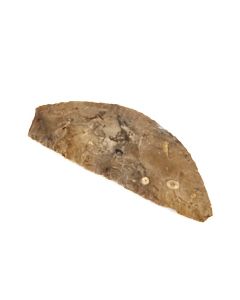 Neolithic sickle from Northern Germany
Neolithic sickle from Northern GermanySmall crescent-shaped blade made of beautiful grey flint. This tool represents an intermediate state within the radical transition from Neolithic to Bronze Age.
Price: on request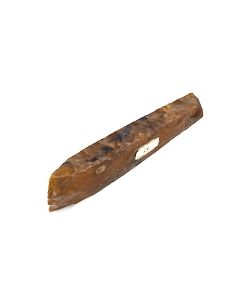 Neolithic axe head from Luetzow in Northern Germany
Neolithic axe head from Luetzow in Northern GermanyNice polished axe from brown flint. It was found more than 100 years ago near the town of Luetzow.
Price: on request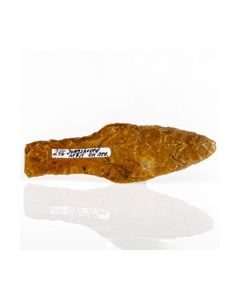 Scandinavian flint dagger
Scandinavian flint daggerNicely worked flint dagger from the transitional period between Late Neolithic and Early Bronze Age. Jungshoved on the Danish Island of Moen was the find spot.
Price: on request Neolithic dagger
Neolithic daggerNicely worked flint dagger of type III. Sprove on the Danish Island of Moen was the find spot. 1700 to 1500 BC.
Price: on request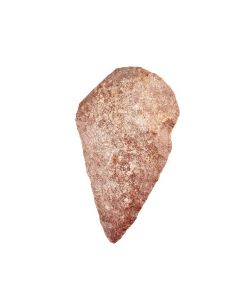 Paleolithic hand axe
Paleolithic hand axeThe universal tool of the older Stone age. It could be used as a borer or a cutter. Approx. 500,000 to 200,000 BC.
Price: on request Neolithic flint sickle
Neolithic flint sickleHalfmoon shaped blade with fine edges. Nice and typical example for this neolithic type of tool.
Price: on request Bronze Age axe head
Bronze Age axe headVery well preserved axe head. Late Bronze Age, 10th to 9th cent. BC.
Price: on request Bronze Age axe head
Bronze Age axe headVery well preserved axe head. Late Bronze Age, 10th to 9th cent. BC.
Price: on request Bronze Age axe head
Bronze Age axe headVery well preserved axe head. Late Bronze Age, 10th to 9th cent. BC.
Price: on request Flintwerkzeug aus Großbritannien
Flintwerkzeug aus GroßbritannienWerkzeug aus Flintstein, mit deutlichen, steinzeitlichen Bearbeitungsspuren. Britisches Neolithikum, möglicherweise früher.
Price: on request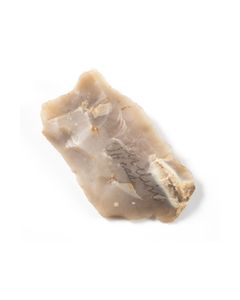 Flintwerkzeug aus Großbritannien
Flintwerkzeug aus GroßbritannienWerkzeug aus Flintstein, mit deutlichen, steinzeitlichen Bearbeitungsspuren. Britisches Neolithikum, möglicherweise früher.
Price: on request Neolithisches Artefakt der Michelsberg-Kultur aus niederländischem Museum
Neolithisches Artefakt der Michelsberg-Kultur aus niederländischem MuseumFund aus 1979 vom Camp-a-Cayaux, bei neolithischer Flintmine in Spiennes, Belgien. 4500 v. Chr. bis 3500 v. Chr. Ex-Museumsstück.
Price: on request Publizierter Tüllenmeißel aus der Bronzezeit - England
Publizierter Tüllenmeißel aus der Bronzezeit - EnglandPerfekt gearbeiteter Meißel aus Bronze. Grundform eines langgestreckten Kegelstumpfes. Wunderschöne gleichmäßige Patina. Ein Fund aus Ostanglien.
Price: on request

